| Elaeocarpus dentatus | |
|---|---|
 | |
| Scientific classification | |
| Kingdom: | Plantae |
| Clade: | Tracheophytes |
| Clade: | Angiosperms |
| Clade: | Eudicots |
| Clade: | Rosids |
| Order: | Oxalidales |
| Family: | Elaeocarpaceae |
| Genus: | Elaeocarpus |
| Species: | E. dentatus |
| Binomial name | |
| Elaeocarpus dentatus | |
| Varieties[2] | |
| |
 | |
| Natural range of Hīnau | |
| Synonyms[3] | |
| |
Elaeocarpus dentatus, commonly known as hinau (Māori: hīnau), is a native lowland forest tree of New Zealand. Other names in Māori for the tree are hangehange, pōkākā, and whīnau.
A member of the family Elaeocarpaceae, it is found on both the North and South Islands of New Zealand, but not on Stewart Island.[4] The leaves are dark green, with a toothed edge. On the underside of the leaf small domatia are present.[5] Clusters of small white flowers are produced in spring, and in late summer the flowers form into a fleshy fruit.[6]
It was officially first recorded for science by botanists Joseph Banks and Daniel Solander on 5 November 1769.[7]
Description
E. dentatus is a tree which reaches a height of around 18 m (59 ft.) and has a trunk of around 1 m (3.2 ft.) in diameter with greyish bark which roughens with age.[8] The sapwood is white and the heartwood is dark brown. The latter, being heavy and strong, is used for making fence posts though is rarely milled because it is often hollow inside.[9] It has leathery leaves[10] which are 10–12 cm long and 2–3 cm wide. On top they are a dark green and an off-white colour below.
It flowers from October to February with flowers very similar to the lily of the valley extending off of 10–18 cm long racemes, each one bearing 8 - 10 flowers.[11] The flowers (around 12mm in diameter) are white and droop down, connected to the raceme by 1 cm long silky pedicels.[12] They are made of 3 - 5 petals which are lobed at their tips and have long anthers which extend out on short filaments. The sepals are covered with many tiny hairs.[11] E. dentatus has 15 pairs of chromosomes (2n = 30) and is bisexual, meaning its flowers contain both the male (stamen) and female (carpel) parts.[13][14]
It fruits from December through to when it ripens in May.[8][12] The fruit are purple-black egg-shaped drupes which are 12–18 mm long and 9 mm wide[8][12] and are attractive to birds.[10] It has 2-celled ovaries and a rugulose (wrinkly) endocarp.[15] The drupes are very fleshy, the flesh making up 56% of the mass, and have a relatively low level of water at 66%.[16] They have a mean mass of 1.05g and have the following compositional breakdown (after moisture is removed): 69.9% N.F.E (Soluble carbohydrates), 21.8% Crude Fiber, 3.4% Crude protein, 3.2% Ash, and 1.7% Lipid.[17]
It is very similar to Elaeocarpus hookerianus but can be distinguished by its larger leaves, flowers and fruit, and its lack of E. hookerianus's distinctive divaricating juvenile to sub-adult form.[12]
 Hinau flowers
Hinau flowers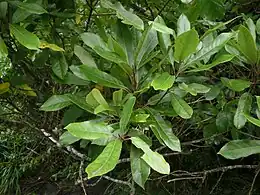 Hinau foliage
Hinau foliage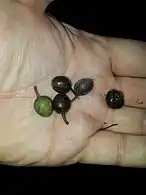 Hinau drupes (fruit)
Hinau drupes (fruit)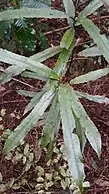 Juvenile foliage
Juvenile foliage
Taxonomy
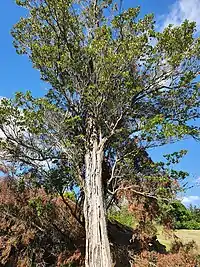
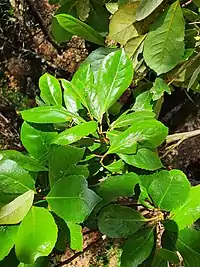
Elaeocarpus dentatus was first described by the German botanists Georg and Johann Forster in their 1779 Characteres Generum Plantarum as Dicera dentata, one of two species in their genus Dicera;[18][note 1] he did not designate a type specimen.[20] It was renamed Elaeocarpus dentatus by the Danish-Norwegian botanist Martin Vahl in the third edition of his Symbolæ Botanicæ, published in 1794.[21] The British botanist Allan Cunningham renamed it superfluously to Elaeocarpus hinau in 1840, in an article in the Annals of Natural History,[22] as did the French Botanist Étienne Raoul in his 1846 Choix de Plantes de la Nouvelle-Zélande ("Selected plants of New Zealand"), this time to Elaeocarpus cunninghamii.[23][note 2]
Varieties
The New Zealand botanist Thomas Cheeseman described a variety of E. dentatus in an article in the 1907 issue of the Transactions and proceedings of the New Zealand Institute. Naming it Elaeocarpus dentatus var. obovatus, he described how, though E. dentatus is variable, he had "never seen specimens with leaves so broad and ovate."[24] This variety is recognised by the New Zealand Plant Conservation Network,[25] New Zealand flora,[26] as well as in Harry Allan's 1961 The flora of New Zealand.[27] As such, they describe two varieties: E. dentatus var. dentatus, the nominate variety, as well as E. dentatus var. obovatus, the variety with wider leaves.[28][12][29] It was not accepted, however, by Anthony Peter Druce in his unpublished 1993 Indigenous vascular plants of New Zealand.[28] It is listed as a synonym of Elaeocarpus dentatus by both The Plant List[30] and World Flora Online,[31] which superseded it.[32] The variety was mentioned in a Department of Conservation Conservation Status Report published in 2017, under the heading: "Data Deficient."[33]
E. dentatus var. obovatus has much wider leaves than the nominate variety, reaching 5–7 cm in length and 3–5 cm in width. The leaves have pits on their undersides and tiny teeth along their edges. Though the adult leaves are wide, they shrink down to thin petioles (leaf stems), and juvenile leaves are also much more narrow. E. d. var. obovatus produces white flowers on racemes, and later purple oval-shaped fruit, that are between 12 and 15 mm long.[25]
Phylogeny
A 2015 thesis established through DNA sequencing that E. dentatus evolved from the same ancestor as E. hookerianus, which can be demonstrated in the cladogram below. They likely split off from their ancestor 13.13 mya, which reached New Zealand through long distance dispersal, similar to other plants.[34]
| |||||||
Etymology
The name of its genus, Elaeocarpus, comes from the Latin elaeocarpus meaning olive-seed; and the specific epithet dentatus, from the Latin dentatus meaning toothed. The epithet obovatus combines the Latin prefix ob, meaning reverse or against, and ovatus, meaning shaped like an egg, since the leaves get wider towards the top rather than the bottom.[25][12]
Ecology
The fruit are eaten (off the ground) by North Island brown kiwi (Apteryx mantelli) who use the seeds as grinding agents to help break down food in their gizzards.[35] To kākā on Kapiti Island, the drupes are an important food source especially in March and, for males, from March all the way until June. This is thought to be because of the different shaped mandible which females have as the fruit actually harden in the months following March, meaning the females are unable to break into them to get at the developing seed, the part that kākā eat. Kākā also rely heavily on hinau and tawa trees to feed their young, both because of their prevalence on the island and their abundant crop of fruit.[36] Weka (Gallirallus australis) eat the fruit which falls onto the ground and are thought to be very important dispersers after the extinction of many of New Zealand's other flightless birds. Hinau seeds may also germinate better after the coat has been torn open and the weka's gizzard might have a similar effect, though more research is needed.[37] Kōkako eat both the leaves and fruit, though they make up a very small proportion of the bird's varied and complex diet.[38] The extremely hard endocarp is thought to be for protection inside the digestive systems of large flightless birds who acted as another disperser by eating fallen fruit. It is also possible, however, that it is to balance the over-eating of their fruit by parrots, like the kākā, who have been found digesting an average of 7.1 seeds per minute in March.[36][39] Kererū also eat the fruit and act as a disperser, though not to the degree weka do.[37]
In New Zealand forests the trunks of trees are crucial to flightless invertebrates who use them as a way to reach the canopy for food and breeding. One study which trapped these invertebrates coming up and down hinau trees found that the most prevalent species coming up were springtails, followed by wasps and ants, spiders, beetles and weevils and mites. Coming down the trunk the most common were the mites, making up 15%. Followed by larvae, springtails, and harvestmen.[40]
Distribution
E. dentatus is endemic to New Zealand and found in both the North and South Islands down to South Westland and Christchurch on the east and west.[12] It grows from sea level to 600 m (1970 ft.), essentially anywhere north of the latitude 43˚30'S.[8][11]
In Māori culture
Mythology
In Māori mythology Māui discovers the origin of fire by stealing the nails of his grandmother Mahuika, the atua (God) of fire, extinguising each one. After realising that Māui had taken all of her fire she threw her last nail at him. It missed and landed first in the Rata (all species under NZ), Hīnau, Kahikatea, Rimu, Mataī, and Miro trees who rejected the fire. It then went on, landing in the kaikōmako, tōtara, patete, pukatea, and māhoe trees who received the fire, considering it a great gift. The trees that accepted the fire can be used to create fire by rubbing dry sticks together, those that do not, like the Hīnau, will not produce fire in this way.[41][42]
Food
The mealy substance which covers the kernel of the hinau's drupe (similar to that of an Olive) was used by Māori to make a kind of cake or bread or, alternatively, a kind of gruel.[43][44][45][46]
The ethnographer Elsdon Best recorded that, though the drupes are edible raw, to make the cake they would first dry the fruit for a couple of days and then pound them with a pestle made of maire or stone. This process, deemed "Tuki," was done in a trough called a "kumete," and was necessary in order to remove the unwanted nuts, stalks and bits of broken skin. The meal was then sifted through baskets make of Cabbage tree leaves such that the stones were trapped in the basket, known as a "tatari" or "Kete puputu." They were then sieved through a finer sieve to ensure that none of the stones known as "karihi," "iwi," or "iho" were left in the meal. Afterwards, the meal was moulded into a large cake which was then cooked for several hours in what he described as a steam oven, likely a Hāngī,[47] inside wooden baskets called "rourou," which were lined with Hound's tongue ferns, in which the meal was also wrapped. Because some meal was still left on the stones, water was used to rub it off and the combination was drunk as a sort of gruel, as it would be called in a western context, and known to Māori as "wai haro." He also reported that it was usually drunk heated, by placing hot stones into it.[44] The cakes, 9-13kgs in weight, would take 1–2 days of cooking to be prepared.[48]
William Colenso in 1880 described the process as being different depending on iwi: some iwi would steep the fruit in water, while others would pound and sift the fruit without a steeping stage.[48] Another 19th century ethnographer, Richard Taylor, described a similar process, though he recorded that the drupes were steeped in running water for a year to remove their "bitterness" and cooked wrapped inside a rangiora leaf. An alternative cooking method he described involved placing the "flour" in heated water at which point it was described as "rerepi."[46] Mākereti Papakura, another ethnographer from the time period also described the fruit being soaked, though she didn't record it being a year long process.[45]
Although some Europeans didn't particularly enjoy the cakes, Elsdon Best writing that: "I prefer my bread and beefsteak,"[44] Mākereti Papakura claimed that Māori considered it a great luxury[45] as demonstrated in their saying: "Kia whakaara koe i taku moe, ko te whatu turei a Rua" meaning "When you awaken me from my sleep let it be for the purpose of eating the whatu turei a Rua (Hīnau meal).[44]
Elaeocarpus dentatus's fruit are in fact a good thing to eat as they contain some fatty acids which may be protective against Cardiovascular disease.[49]
Dye and other uses
The bark produces a brown dye which, when dipped in a ferrugineous swamp (one containing Iron), turns it into a bright and durable black colour.[50]
Young seedlings were tied with a knot and left to grow into the shape of a walking stick. They were then cut and used as such.[51] The bark was used to make bags which served various purposes, such as for the preparation of Raupō pollen bread.[52]
Cultivation
E. dentatus prefers a rich, moist soil in partial shade.[10] To grow, press the seed well in and cover with 5mm of soil. It takes around 6 months to germinate and fresh fruit can be used.[53][12]
Notes
- ↑ The other being Dicera serrata (Wineberry), which is now called Aristotelia serrata.[19]
- ↑ He originally spelt it with just one i.[23]
Citations
- ↑ "Elaeocarpus dentatus". Plants of the World Online. Retrieved 21 April 2021.
- ↑ "NZOR Name Details - Elaeocarpus dentatus (J.R.Forst. & G.Forst.) Vahl".
- ↑ "Elaeocarpus dentatus var. Dentatus".
- ↑ "Hīnau, Elaeocarpus - Faculty of Science - The University of Science". The University of Auckland. Archived from the original on 8 February 2013. Retrieved 25 December 2011.
- ↑ "Elaeocarpaceae 2 (Wineberry family) - Faculty of Science, University of Auckland". Archived from the original on 16 July 2012. Retrieved 25 December 2011.
- ↑ "Elaeocarpus dentatus Hinau". bushmansfriend.co.nz. Retrieved 25 December 2011.
- ↑ "Loading... | Collections Online - Museum of New Zealand te Papa Tongarewa".
- 1 2 3 4 Salmon JT (1998). Native Trees of New Zealand: v. 1 (Mobil New Zealand Nature Series). New Zealand: Reed Publishing. pp. 39 (There are no page numbers this is the number that Hīnau is given). ISBN 0790005581.
- ↑ Cockayne L, Turner EP (1928). The trees of New Zealand. Wellington, New Zealand: W.A.G. Skinner. p. 150.
- 1 2 3 Paddison V (1999). The Gardener's Encyclopaedia of New Zealand Native Plants. New Zealand: Random House. p. 205. ISBN 1869620925.
- 1 2 3 Eagle A (2006). Eagles Complete Trees and Shrubs of New Zealand. Wellington, New Zealand: Te Papa Press. p. 270. ISBN 9780909010089.
- 1 2 3 4 5 6 7 8 "Elaeocarpus dentatus var. dentatus". New Zealand Plant Conservation Network. Retrieved 29 November 2020.
- ↑ Beentje H (2010). The Kew Plant glossary : an illustrated dictionary of plant terms. Williamson, Juliet. Richmond, Surrey: Kew. ISBN 978-1-84246-422-9. OCLC 464589004.
- ↑ "Elaeocarpus dentatus - The University of Auckland". www.nzplants.auckland.ac.nz. Retrieved 18 December 2020.
- ↑ "Flora of New Zealand | Taxon Profile | Elaeocarpus dentatus". www.nzflora.info. Retrieved 19 December 2020.
- ↑ Williams CK (1982). "Nutritional Properties of Some Fruits Eatenby the Possum Trichosurusvulpecula in Anew Zealand Broadleaf – Podocarp Forest" (PDF). New Zealand Journal of Ecology. 5: 17.
- ↑ Williams CK. "Nutritional Properties of Some Fruits Eatenby the Possum Trichosurusvulpecula in Anew Zealand Broadleaf – Podocarp Forest" (PDF). New Zealand Journal of Ecology. 5: 17 & 18 – via https://newzealandecology.org.
{{cite journal}}: External link in|via= - ↑ Forster 1776, pp. 79–80.
- ↑ de Lange 2012.
- ↑ Coode, M. J. E. (1984). "Elaeocarpus in Australia and New Zealand". Kew Bulletin. 39 (3): 509–520. doi:10.2307/4108594. JSTOR 4108594.
- ↑ Vahl & Forsskål 1790, p. 66.
- ↑ Cunningham 1840, pp. 22–26.
- 1 2 Raoul 1846, p. 25.
- ↑ Cheeseman 1907, p. 442.
- 1 2 3 NZPCN, p. Obovatus
- ↑ "Flora of New Zealand | Taxon Profile | Elaeocarpus dentatus var. obovatus". www.nzflora.info. Retrieved 29 September 2021.
- ↑ Allan, Harry Howard (1961). Flora of New Zealand. Indigenous Tracheophyta: Psilopsida, Lycopsida, Filicopsida, Gymnosphermae, Dicotyledones. Vol. 1. New Zealand: Government Printer. pp. 332–333.
- 1 2 de Lange 2007.
- ↑ "Flora of New Zealand | Taxon Profile | Elaeocarpus dentatus". www.nzflora.info. Retrieved 11 October 2021.
- ↑ "Elaeocarpus dentatus var. obovatus Cheeseman – The Plant List". www.theplantlist.org. Retrieved 29 November 2020.
- ↑ "Elaeocarpus dentatus var. obovatus Cheeseman". www.worldfloraonline.org. Retrieved 29 November 2020.
- ↑ "Home – The Plant List". www.theplantlist.org. Archived from the original on 23 May 2019. Retrieved 29 November 2020.
- ↑ de Lange PJ, Rolfe JR, Barkla JW, Courtney SP, Champion PD, Perrie LR, Beadel SM, Ford KA, Breitwieser I, Schönberger I, Hindmarsh-Walls R, Heenan PB, Ladley K (30 November 2020). "Conservation status of New Zealand indigenous vascular plants, 2017" (PDF). New Zealand Plant Conservation Network. p. 22.
- ↑ Phoon 2015, p. 50.
- ↑ Reid B, Ordish RG, Harrison M (January 1982). "An analysis of the gizzard contents of 50 North Island brown kiwis, Apteryx australis mantelli, and notes on feeding observations" (PDF). New Zealand Journal of Ecology. 5: 76–85. JSTOR 24052678.
- 1 2 Ron J. Moorhouse. "THE DIET OF THE NORTH ISLAND KAKA (NESTOR MERIDIONALIS SEPTENTRIONALIS) ON KAPITI ISLAND" (PDF). New Zealand Journal of Ecology. 21: 143–150.
- 1 2 Carpenter JK, Kelly D, Moltchanova E, O'Donnell CF (June 2018). "Introduction of mammalian seed predators and the loss of an endemic flightless bird impair seed dispersal of the New Zealand tree Elaeocarpus dentatus". Ecology and Evolution. 8 (12): 5992–6004. doi:10.1002/ece3.4157. PMC 6024123. PMID 29988419.
- ↑ R.O. POWLESLAND. "THE FOODS, FORAGING BEHAVIOUR AND HABITAT USE OF NORTH ISLAND KOKAKO IN PUKETI STATE FOREST, NORTHLAND" (PDF). New Zealand Journal of Ecology. 10: 120–127.
- ↑ Michael James Thorsen, Katharine J.M. Dickinson and Philip J. Seddon. "Seed dispersal systems in the New Zealand flora". Perspectives in Plant Ecology, Evolution and Systematics. 11: 302 – via Researchgate.
- ↑ Moeed A, Meads MJ (January 1983). "Invertebrate fauna of four tree species in Orongorongo Valley, New Zealand, as revealed by trunk traps" (PDF). New Zealand Journal of Ecology: 39–53.
- ↑ "How Māui brought fire to the world / Māori Myths, Legends and Contemporary Stories / Te Reo Māori / Support materials / Home - Mātauranga Māori". eng.mataurangamaori.tki.org.nz. Retrieved 17 December 2020.
- ↑ Taylor, Richard (1855). Te Ika a Maui, or New Zealand and its inhabitants. USA: Wertheim and Macintosh. p. 30.
- ↑ Salmon, John T. (1986). The Native Trees of New Zealand. New Zealand: Heinemann Reed. p. 176. ISBN 0790001047.
- 1 2 3 4 Best, Elsdon (1903). "Food products of Tuhoeland: being notes on the food-supplies of a non-agricultural tribe of the natives of New Zealand: together with some account of various customs, superstitions etc. pertaining to foods". Transactions of the New Zealand Institute: 55–56.
- 1 2 3 Papakura, Maggie (1938). The Old-time Maori. London, UK: Gollancz. p. 211.
- 1 2 Taylor, Richard (1855). Te Ika a Maui, or New Zealand and its inhabitants. USA: Wertheim and Macintosh. p. 393.
- ↑ Elsdon, Best. "Journal of the Polynesian Society: Notes On The Art Of War As Conducted By The Maori Of New Zealand: Part VIII". www.jps.auckland.ac.nz. p. 195. Archived from the original on 6 February 2018. Retrieved 2 June 2021.
An umu (steam oven) was prepared, heated, and covered in, save a small hole at the top, through which the steam rose.
- 1 2 Colenso, William (1880). "On the vegetable food of the ancient New Zealanders before Cook's visit". Transactions and Proceedings of the Royal Society of New Zealand. 13: 3–38.
- ↑ Cambie RC, Ferguson LR (2003). "Potential functional foods in the traditional Maori diet". Mutation Research. 523–524: 109–17. doi:10.1016/s0027-5107(02)00344-5. PMID 12628508.
- ↑ Taylor, Richard (1855). Te Ika a Maui, or New Zealand and its inhabitants. USA: Wertheim and Macintosh. p. 446.
- ↑ Best, Elsdon. "Maori forest lore : being some account of native forest lore and woodcraft, as also of many myths, rites, customs, and superstitions connected with the flora and fauna of the Tuhoe or Ure-wera District - Part 1". Transactions of the New Zealand Institute.
- ↑ Taylor, Richard (1855). Te Ika a Maui, or New Zealand and its inhabitants. USA: Wertheim and Macintosh. p. 391.
- ↑ "Seed collection and propagation guide for native trees and shrubs". www.doc.govt.nz. Retrieved 19 December 2020.
References
Websites
- de Lange, Peter (2012). "Aristotelia serrata". New Zealand Plant Conservation Network. Retrieved 26 September 2021.
- de Lange, Peter (2007). "Elaeocarpus dentatus var. dentatus". New Zealand Plant Conservation Network. Retrieved 26 September 2021.
- "Elaeocarpus dentatus var. obovatus". New Zealand Plant Conservation Network. Retrieved 29 November 2020.
Journals
- Cunningham, Allan (1840). "Specimen of the Botany of the Islands of New Zealand". Annals of Natural History. 4 – via Biodiversity Heritage Library.
- Cheeseman, Thomas (1907). "Contributions to a fuller Knowledge of the Flora of New Zealand". Transactions and Proceedings of the New Zealand Institute. 39 – via the Internet Archive.
Books
- Forster, Johann Reinhold; White, B.; Elmsly, P.; Cadell, T. (1776). Characteres generum plantarum, quas in itinere ad insulas maris Australis, : collegerunt, descripserunt, delinearunt, annis 1772-1775. Londini: Prostant apud B. White, T. Cadell, & P. Elmsly.
- Raoul, Etienne (1846). Choix de plantes de la Nouvelle-Zélande (in French). Fortin, Masson.
- Vahl, M.; Forsskål, Peter (1790). Symbolae botanicae, sive plantarum, tam earum, quas in itinere, imprimis orientali. Hauniae: imprensis auctoris, excudebant N. Möller et filius.
- Phoon, Sook-Ngoh (2015). Systematics and biogeography of Elaeocarpus (Elaeocarpaceae) (Thesis). James Cook University.